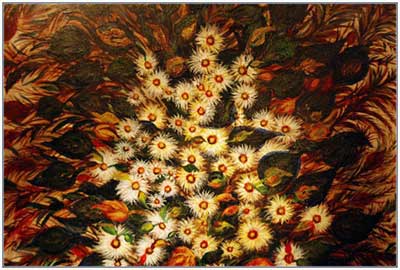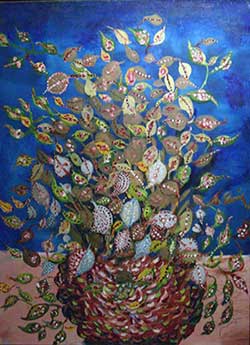Séraphine of Senlis (1864-1942)

In May 1962, an exhibition was held at the Galerie Pierre Birtschansky in Paris of the work of a mysterious self-taught painter who had been hailed by the German art-dealer and collector Wilhelm Uhde as a "modern Primitive". Her name was Séraphine Louis, born into a peasant family in a village near the Ile-de-France town of Senlis, and employed for most of her life as a domestic servant. After her death in a lunatic asylum in 1942, her name fell into obscurity, and this was the first major postwar exhibition of her work.
The writer and critic Nino Frank was asked to write the Introduction to the Catalogue of the 1962 Exhibition, and below is my translation of his text. At certain points I have followed the sense rather than the actual words, as the French is more poetic, bordering on flowery, than can comfortably be rendered in English.
This text illustrates well the preferred approach of Nino Frank when writing on art, or indeed on cinema: he felt so passionately about literature that he could never resist introducing literary references into his critical pieces. In this short text, there are no fewer than four: in the title and first lines, to Thomas Hardy and Jude the Obscure; at the end of the same paragraph, to Flaubert and Un cœur simple; towards the end of the piece, to Gérard de Nerval and his contrasting heroines Sylvie and Aurélia; and at the very end, to the Abbé Prévost and Manon Lescaut. There are several paragraphs on the paintings themselves, but it is clear that it is the artist's (very strange) life which holds the real fascination for him.
In this present century (2008), the film director Martin Provost was equally fascinated by her life, and made the feature film Séraphine, now available on DVD.

Séraphine The Obscure
by Nino Frank
(translated from the French)
To the uninformed observer, an image of Séraphine Louis, known as Séraphine of Senlis, which immediately comes to mind is the touching image of the 'Obscure', as Thomas Hardy might have named her. One day in 1912, the art lover Wilhelm Uhde discovered that his old cleaning-lady painted extraordinary pictures, in which the young German, mad about the Romantics, believed he had found a re-creation of the "Gothic miracle". At that time she was a sad-faced woman in her fifties, with patches in her clothes, the daughter of illiterate peasants, shut away in her own solitude and already subject to mockery. The simple heart, to quote Flaubert.
It is easy to see this work as working-class painting of reality, as twentieth century primitivism. It took the shrewd Apollinaire some time to understand that it was inappropriate to mock the naïvety of Rousseau, a Sunday painter perhaps but, throughout the week, master of a special genius which in its single-mindedness can be likened to that of Paul Cézanne, that other innocent. The case of Séraphine, who was born in 1864 and died in 1942 after three years of madness in the asylum of Clermont, in the Oise, is also not one which can be understood in a single delighted glance.
Servant with a large heart perhaps, with a strange heart certainly. Her paintings from 1912 have disappeared, in contrast to the Rousseaus and Picassos which, in 1914-18, were confiscated from the "enemy subject" Uhde. It is said that these paintings were still-lifes. When in 1923, through an exhibition of regional painters in Senlis town hall, Uhde rediscovered Séraphine, this "enemy subject" again secured the rights to the whole production of the old woman, who by that time could no longer even cope with her work as a washer of dishes.
To mix her paints, she was stealing the sacred oil from the statues of the Virgin in the churches. And Uhde, once again gripped by her painting and by the "miracle" of this cradle of the Gothic, jealously hid Séraphine's flower-paintings in his house in Chantilly. Was this to keep the old woman's obscure secret for himself? Her protector would never know anything about her painting methods, for Séraphine never allowed him into the bedroom where she shut herself up to paint.
What went on there? No doubt she had her heaven and her hell there, both of them peopled with eyes at the centre of her flowers. And, of course, the first key to this bedroom was religion. "My parents were as ignorant as I am," she declared. "They did not choose my name, which is much too beautiful for me: it was the priest..." The money which Uhde gave her for her paintings (eight francs a picture) soon went in buying religious knick-knacks, Saint-Sulpice style. In the flamboyant Gothic of Séraphine's flowers, we can surely detect the bursting heart of Mary, and see the burning bush, even if they derive from the rose windows of Senlis cathedral. Their whole composition appears to be ordered in accordance with a rhythm of perpetual adoration.
But, Blessed Virgin or not, we remain in the naïf. Here there is none of the celebrated 'naïve style': no reference to the real, no careful technique, analysis or precision of line. What pours out here are wild visions, the fires of excess, the frenzy of a hallucination which is no longer simple. Sometimes her flowers merge into a rotating movement which evokes Van Gogh's suns – but Séraphine had never seen a Van Gogh. Sometimes she achieves the decorative splendour attained by Gustave Moreau, after which he ran out of steam - but she had never seen a Moreau. Sometimes she re-invents the East and its sexual magic, this old woman whose only journey was on foot from Senlis to Chantilly, on the verge of madness, to beg Uhde to exhibit her paintings in Paris, as he had promised her.
Raving, Séraphine wandered through the streets, announcing the end of the world. "My pictures are blest, they are your only chance of salvation..." she wailed. How can we not think of Gérard Labrunie, known as Gérard de Nerval, he too born a few kilometres from here, he too promised to a miserable death? If the simple heart of Séraphine is of the same kind as that of Sylvie, the monumental frenzy of her paintings could be very close to the progression towards the sublime that we sense in Aurélia...Both aspects reveal genius in its pure state, marked with the colours of fate, against the background of a nature finally free.
A final reference suggested to me by Emile Szittya: at Saint Nicolas-d'Assy, where Séraphine Louis was born, three kilometres from Senlis, is the tomb of the Abbé Prévost, inventor of the most beautiful love story in French literature.
* * * * *
In 1986, Alain Vircondelet wrote a biography, Séraphine de Senlis (Une vie), which he followed up in 2008 with Séraphine (de la peinture à la folie). He later accused the makers of the 2008 film of plagiarising his material, and took them to court.
Be that as it may, since the release of the film several other authors have taken an interest in writing about Séraphine, and there have been two exhibitions. As the poster below shows, her paintings enjoyed a special exhibition at the Musée Maillol, Paris in 2012, and this gallery holds a small number of them in its permanent collection:

The year 2014 saw the 150th anniversary of her birth, for which the Musée d'Art et d'Archéologie of the city of Senlis held an important exhibition, from June 2014 to January 2015.